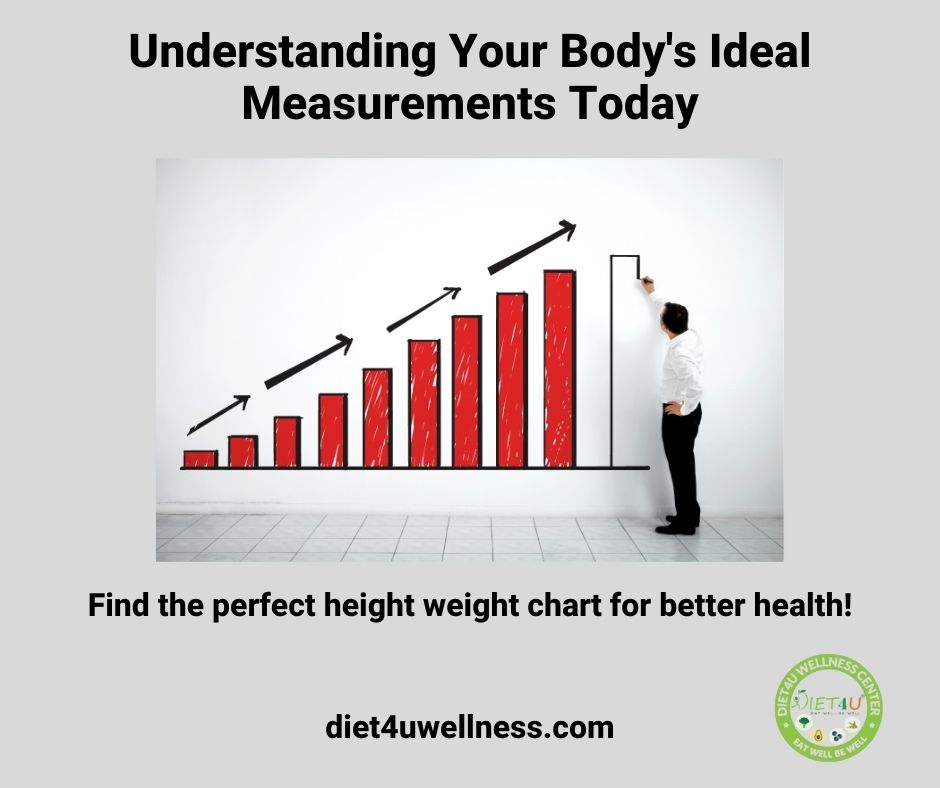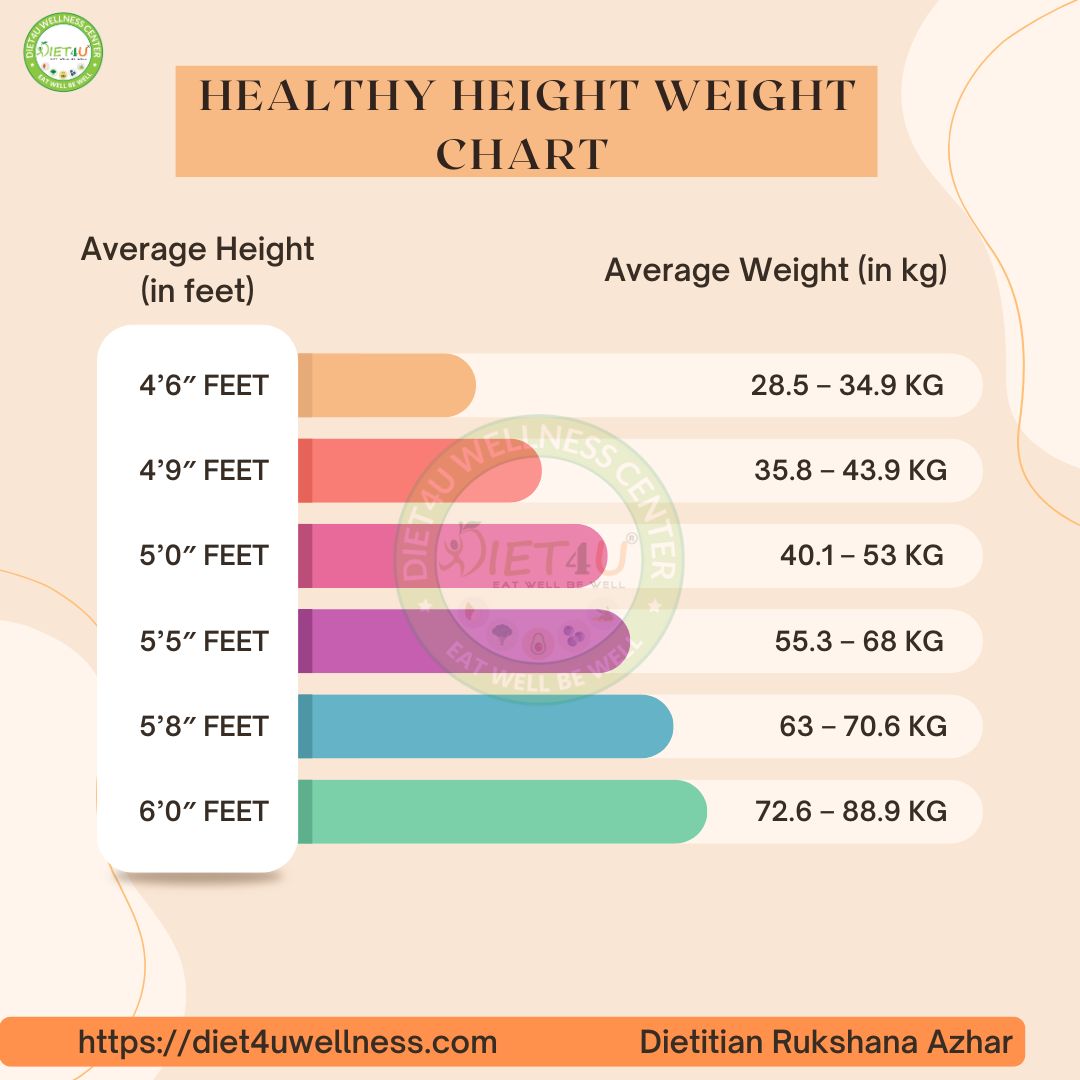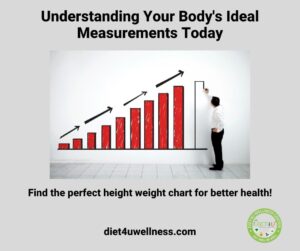
The Importance of the Height Weight Chart in Maintaining a Healthy Lifestyle
Table of Contents
A height weight chart is a ratio calculated to determine if a person of a certain age, sex, and gender falls within a medically healthy weight per their Height. Height and Weight are the two critical factors that govern an individual’s health. One needs to maintain an ideal height-weight ratio to avoid chronic disorders and lead a comparatively healthy life—this article by DIET4U WELLNESS, in association with India’s renowned dietician, Dt. Rukhsana Azhar explains the fundamental height weight chart in detail.
HEIGHT WEIGHT CHART FOR MEN AND WOMEN
The Ideal Height and weight chart for men, women, children, and the elderly differs drastically; therefore, it is impossible to cater to all age demographics in one chart or ratio. Height and Weight help ensure that an individual is in good shape and health.
Ideal Height & Weight for Men
Men’s heights are generally classified as short, short, average, tall, very tall, and extremely tall. So, one’s Weight also depends on one’s Height.
Below is a height weight chart for men:
| Average Height (in feet) | Average Weight (in kg) |
| 4’6″ feet | 28.5 – 34.9 kg |
| 4’7″ feet | 30.8 – 38.1 kg |
| 4’8″ feet | 33.5 – 40.8 kg |
| 4’9″ feet | 35.8 – 43.9 kg |
| 4’10” feet | 38.5 – 46.7 kg |
| 4’11” feet | 40.8 – 49.9 kg |
| 5’0″ feet | 40.1 – 53 kg |
| 5’1″ feet | 45.8 – 55.8 kg |
| 5’2″ feet | 48.1 – 58.9 kg |
| 5’3″ feet | 50.8 – 60.1 kg |
| 5’4″ feet | 50.0 – 64.8 kg |
| 5’5″ feet | 55.3 – 68 kg |
| 5’6″ feet | 58 – 70.7 kg |
| 5’7″ feet | 60.3 – 73.9 kg |
| 5’8″ feet | 63 – 70.6 kg |
| 5’9″ feet | 65.3 – 79.8 kg |
| 5’10” feet | 67.6 – 83 kg |
| 5’11” feet | 70.3 – 85.7 kg |
| 6’0″ feet | 72.6 – 88.9 kg |
Ideal Height & Weight for Women
It is generally considered that women naturally have a smaller frame and a lower body weight than men. Additional factors for women, like frequent hormonal changes every month, age, and lifestyle changes, impact a woman’s health over time.
| Average Height (in feet) | Average Weight (in kg) |
| 4’6″ feet | 28.5 – 34.9 kg |
| 4’7″ feet | 30.8 – 37.6 kg |
| 4’8″ feet | 32.6 – 39.9 kg |
| 4’9″ feet | 34.9 – 42.6 kg |
| 4’10” feet | 36.4 – 44.9 kg |
| 4’11” feet | 39.0 – 47.6 kg |
| 5’0″ feet | 40.8 – 49.9 kg |
| 5’1″ feet | 43.1 – 52.6 kg |
| 5’2″ feet | 44.9 – 54.9 kg |
| 5’3″ feet | 47.2 – 57.6 kg |
| 5’4″ feet | 49.0 – 59.9 kg |
| 5’5″ feet | 51.2 – 62.6 kg |
| 5’6″ feet | 53.0– 64.8 kg |
| 5’7″ feet | 55.3 – 67.6 kg |
| 5’8″ feet | 57.1 – 69.8 kg |
| 5’9″ feet | 59.4 – 72.6 kg |
| 5’10” feet | 61.2 – 74.8 kg |
| 5’11” feet | 63.5 – 77.5 kg |
| 6’0″ feet | 65.3 – 79.8 kg |
Ideal Height & Weight for Children
Children’s Ideal Weight and Height vary significantly based on age, gender, heredity, and growth patterns. The height-to-weight ratio also depends on critical factors like body composition, growth spurts, and nutrition levels. Consulting a board-certified dietician during these crucial years of youth is a wise idea to ensure a proper height-to-weight ratio is maintained.
Below is a height weight chart for children according to their age:
| Age | Weight | Height |
| 0-6 Months | 3.3 kgs – 7.5 kgs | 19.4 to 25.9 inches |
| 7-12 Months | 7.9 kgs – 9.2 kgs | 25.5 Inches to 29.2 Inches |
| 1-2 Years | 9.5 kgs – 12 kgs | 29.6 Inches to 33.4 Inches |
| 2-4 Years | 12 kgs – 15 kgs | 29.6 Inches to 337.7 Inches |
| 4-6 Years | 15.4 kgs – 20 kgs | 39.5 Inches to 45.5 Inches |
| 6-8 Years | 19.5 kgs – 25.5 kgs | 45.5 Inches to 50.5 Inches |
| 8-10 Years | 25.5 kgs – 31.9 kgs | 50.5 Inches to 55 Inches |
| 10-12 Years | 32 kgs – 41.5 kgs | 54.5 Inches to 59 Inches |
| 12-14 Years | 42 kgs – 47.6 kgs | 60 Inches to 62.5 Inches |
| 14-16 Years | 45 kgs – 53 kgs | 62.5 Inches to 64 Inches |
| 16-18 Years | 53 kgs – 56.7 kgs | 64 Inches to 64.2 Inches |
| 18-20 Years | 56 kgs – 58 kgs | 64.2 Inches to 64.5 Inches |
WHAT DOES HEIGHT WEIGHT CHART CONVEY?
A height and weight chart conveys an interrelationship between a child’s Height and weight ratio based on age, gender, and medical conditions. Such a chart helps assess whether a child has a healthy weight for their current age and Height and determines healthy growth patterns for their age demographic.
Some of the critical points that a height weight chart indicates are:
Health conditions
The height weight charts describe the relationship between Height and Weight. These ratios can also signify whether the children are healthy. Weights and heights can also determine whether a child is healthy or suffers from malnutrition. If a child shows unhealthy height-weight ratios, then special attention can be given to them from a nutritional aspect.
Developmental patterns
Height weight charts help track a child’s progress toward a healthy lifestyle. An abnormal height-weight ratio can show problems like growth stunting, delayed puberty, and even unnatural weight gain. Unnatural weight changes can also be associated with underlying diseases.
Nutritional status
The height weight chart helps determine whether a child is within the average Weight range or underweight. If a child is underweight, necessary changes to one’s current lifestyle and food habits must be made.

BENEFITS OF USING A HEIGHT WEIGHT CHART
Although a height weight chart is not very popular amongst the masses, it does have many benefits, which this article has listed below.
Monitoring health goals
People can use height-weight health charts to track their ideal Height and Weight and progress toward their fitness goals.
Indicating health risks
Often, people think that height and weight charts are only meant to satisfy societal norms, but that is not entirely true. Many diseases, like AIDS and early stages of cancer, are indicated by sudden weight loss and loss of appetite. Such sudden weight loss and imbalances with Height can be found in height weight charts. Even conditions like PCOS are indicated by sudden weight gain and difficulty in losing Weight. These conditions can be detected early if much more attention is given to such height weight charts and their importance is conveyed across society.
Calculating BMI
BMI, or body mass index, is calculated using Weight and Height. It helps assess body percentages and prevent potential future health and chronic diseases, which could be acted upon early by monitoring an individual’s BMI.
HOW TO CALCULATE HEIGHT AS PER WEIGHT?
- To calculate one’s ideal Height based on one’s Weight, One Needs to use the BMI (body mass index) as a reference. The BMI formula can help establish a relationship between Height and Weight.
- First, the BMI formula should be taken into consideration.
- Then, a healthy BMI range should be chosen.
- As per one, again, considering the BMI formula, Height and Weight are added to the formula, and the ideal BMI is calculated.
BMI = WeightWeight/ (Height (m) * Height (m))
Example: If the Weight is 70 kg and the Height is 1.75 m.
BMI = 70 kg / (1.75 m * 1.75 m) = 22.86
Interpreting BMI:
Once BMI is calculated, the categories can be interpreted below:
- Underweight: BMI less than 18.5
- Normal Weight: BMI 18.5 – 24.9
- Overweight: BMI 25 – 29.9
- Obesity (Class I): BMI 30 – 34.9
- Obesity (Class II): BMI 35 – 39.9
- Obesity (Class III): BMI 40 or higher
HOW TO MAINTAIN AN IDEAL HEIGHT WEIGHT CHART?
Proper food, diet, and exercise routines are needed to maintain an ideal weight-height ratio. Height is directly determined by genetics and hereditary factors, along with a minor influence on the type of diet, eating habits, and regular exercise. Most of the Height is determined during the peak growing period, adolescence.
Healthy diet
No matter what exercises one does, a healthy diet regime is crucial with the help of all the board-certified dieticians like Dt. Rukhsana Azhar, one should consume a specialized curated diet including fruits and vegetables, lean proteins like chicken and fish, whole grains, and healthy fats like nuts and seeds, and avoid excess oil and sugar. Portion size should be controlled without going for any excessive diet. And lastly, hydration is the key.
Regular exercises
Basic cardiovascular exercises, such as brisk walking, jogging, cycling, and swimming, improve health and burn calories. Light to moderate exercise every day is very important for proper health maintenance.
Better lifestyle
To lose Weight and increase Height, one must implement a healthy lifestyle. Adequate sleep is the most basic and essential thing one should do for better health, and 7-8 hours of deep sleep are critical. Stress management is also vital, as chronic stress can trigger other unhealthy habits.
Realistic goals
To lose Weight, one should always set realistic goals, not unrealistic desires. Weight loss should be gradual and under the guidance of a board-certified dietician like Dr. Rukhsana Azhar. A steady approach is always better than a hasty way of losing Weight or increasing height unnaHeighty. One should always keep a record of daily progress, which would motivate one to set further goals.
Professional help
For a healthy and regulated weight loss journey, one should definitely seek help from professionals like board-certified dieticians like Dt. Rukhsana Azhar. Dieticians give personalized nutritional advice and curate specialized diets for every patient, depending on their goals and weight loss targets.
FAQs ON HEIGHT WEIGHT CHART
Is a height weight chart accurate?
It is accurate. It provides a general visual representation of someone’s ideal Height based on someone’s Weight. However, unlike the BMI chart, the chart does not consider factors like body mass and muscle mass.
Is a height weight chart the same as the BMI chart?
No. They are similar but not exactly the same. BMI is a chart that uses a formula to calculate body mass based on one’s Height and Weight and determine if the person falls within the underweight, overweight, or standard range. At the same time, a height weight chart represents an ideal height based on someone’s Weight.
What is a healthy height weight chart range?
A healthy height-weight range depends on vectors, age, and gender, such as r, music, and mass. Generally, the ideal BMI is between 18 to 25. Standing above 25 is considered overweight, and anything below 18 is underweight.
Does the height weight chart differ for men and women?
Yes. The height weight chart definitely differs for men and women, as mentioned in the article above.

Hello My Name is Dt. Ruksana Azhar and I am a certified dietician and providing online & offline services for Weight Management, PCOS/PCOD Management, Diabetes Management , etc. I have 12+ years of experience in the Apollo Hospital Delhi , Max Super Specialty Hospital Delhi, Lilavati Hospital Mumbai and VLCC healthcare Mumbai. I loves to write healthcare and lifestyle related blog. My favorite part of being a doctor is the opportunity to directly improve the health and wellbeing of my patients and to develop professional and personal relationships with them.



